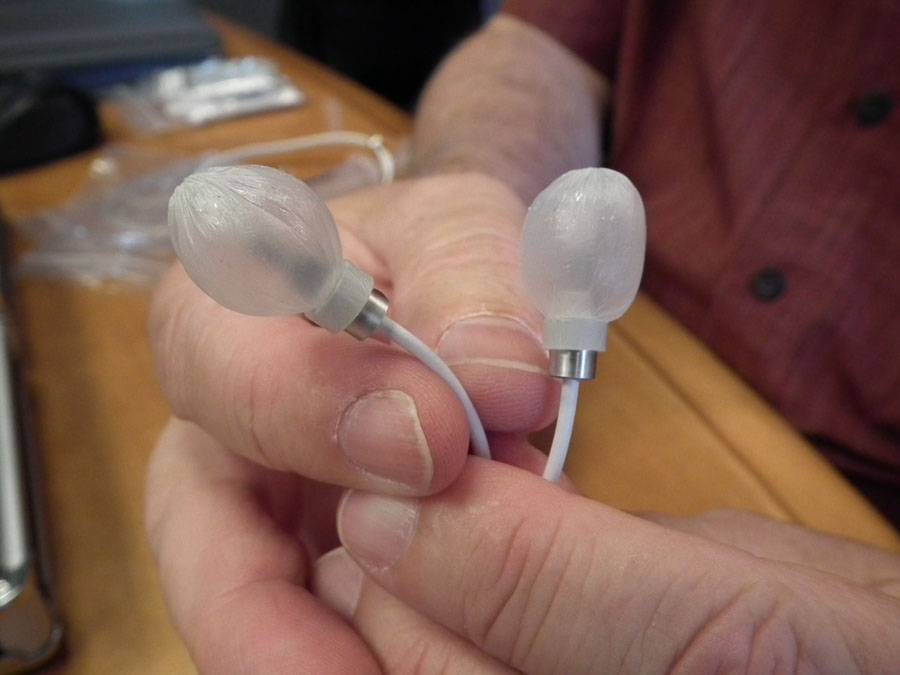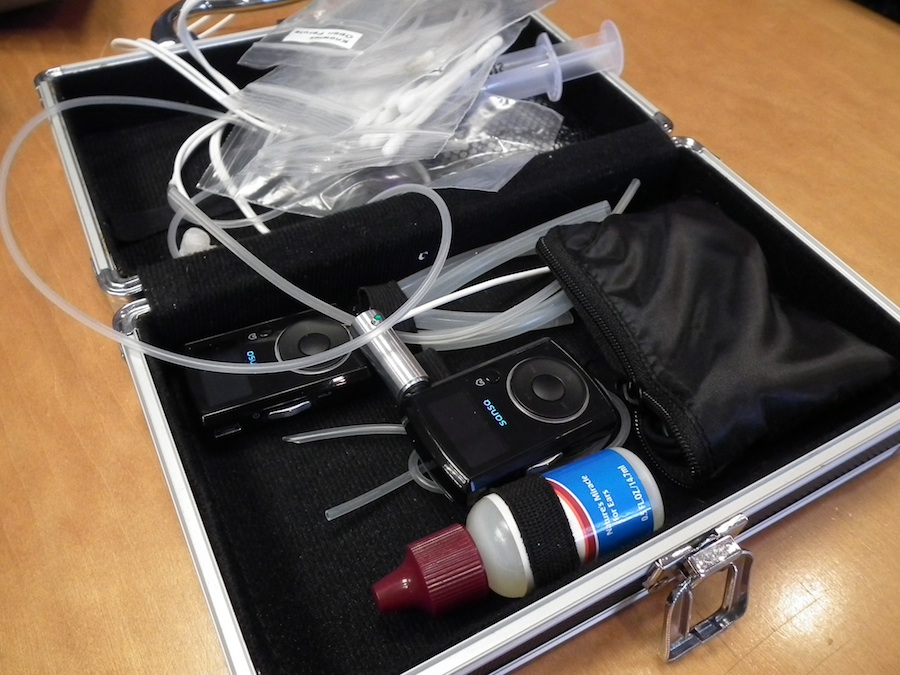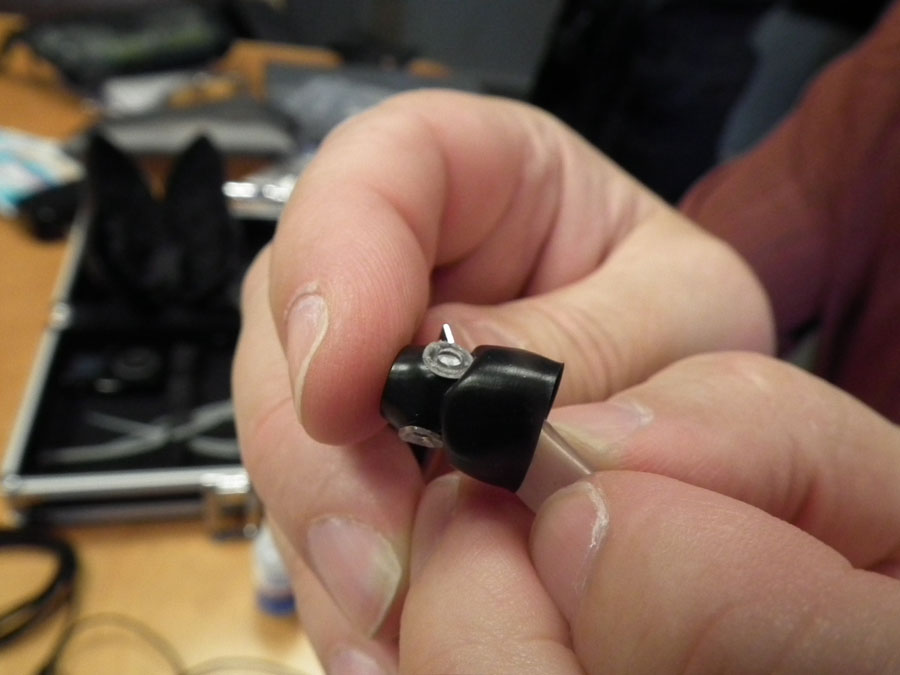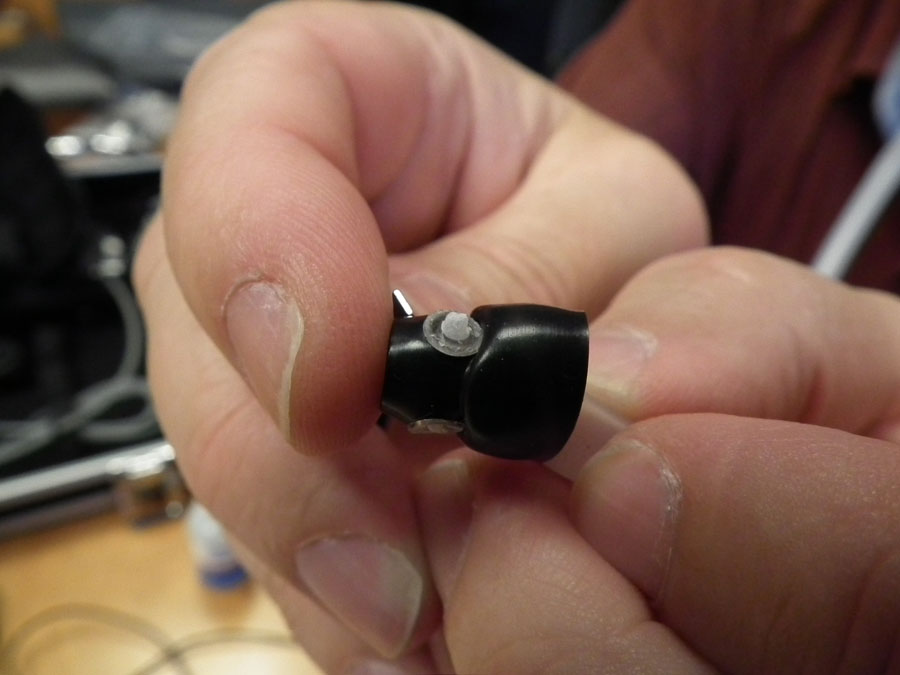Through the Diaphonic Lens Page 3

Stephen showed up at the office, we unpacked his test kit, and began listening. We spent about an hour listening to two prototypes, employing both variations on the ADEL concept: first, a system using the "balloons" (the set we listened to were built around the familiar balanced armature drivers used in Etymotic's ER-4 series); second, a series of modified eartips (using one, two, and three ADEL membranes), mounted on Skullcandy's popular Titan earphones, a fairly bass-heavy unit that's garnered some serious respect as a budget choice for the discerning listener.
 We began our listening session with the balloons, preinflated in this case by a hand pump. In production versions the diaphonic pump (a prototype is seen here, attached to the Sansa media player) will handle the inflation on its own.
We began our listening session with the balloons, preinflated in this case by a hand pump. In production versions the diaphonic pump (a prototype is seen here, attached to the Sansa media player) will handle the inflation on its own.
Insertion was a bit on the alienating side, though not terribly difficult (the membrane is soft to the touch) but they were comfortable once in place. We played around a bit with insertion pressure, aiming for a fit just at the point at which the "occlusion effect" - the boomy accentuation of the resonant peak of the ear canal you experience as the muffled sound of your own voice when sticking your fingers in your ears - kicks in.
Once I had them in, I listened to a few favorites (caveat: this was a preview of a prototype, and not an organized test, so these were simply recordings I knew well and had on hand rather than references): Michael Tilson Thomas conducting the New World Symphony Orchestra in Morton Feldman's dense "Coptic Light"; Richard and Linda Thompson's "I Want to See the Bright Lights Tonight"; Captain Beefheart and the Magic Band's sparse, bass-rich "I'm Gonna Booglarize You, Baby"; and the ornate pop soundscape of Peter Gabriel's "In Your Eyes," a suggestion of Ambrose's.
I wasn't blown away by the audio performance of the balloons - they sounded great, much as good in-ears should sound; well-balanced, detailed, and not overly bassy. Still, I can't pass judgment based on a single listening session, and A-B comparisons with other units would be difficult given the insertion process and very different feel in the ear. They do behave as advertised - certainly minimize occlusion effects - wearing them, you can open and close your mouth (and, according to Ambrose, even drink or eat) without anywhere near the amount of distracting jaw noise or the sensation that the changing shape of the ear canal is interrupting the seal of the phones. Interesting, to say the least, and if it works for everyone it would certainly make me question the entire notion of custom-fitted in-ears (since the flexibilty overcomes the major drawback of such units), but I wasn't entirely sold on the concept.
 We moved next to an unmodified set of Skullcandy Titans. After listening a bit, Ambrose swapped these out for a set mounted with eartips modified with by the addition of a single lens unit, then from there on to a pair modified with two lenses. I spend several minutes listening to each one, comparing back to the unmodified unit, but in neither case did I notice much of a change in overall sound, or in the occlusion effect. The Titans still sounded much as they did in the beginning - certainly acceptable for the price, but exhibiting tons of bass emphasis and without a lot of detail on the top end.
We moved next to an unmodified set of Skullcandy Titans. After listening a bit, Ambrose swapped these out for a set mounted with eartips modified with by the addition of a single lens unit, then from there on to a pair modified with two lenses. I spend several minutes listening to each one, comparing back to the unmodified unit, but in neither case did I notice much of a change in overall sound, or in the occlusion effect. The Titans still sounded much as they did in the beginning - certainly acceptable for the price, but exhibiting tons of bass emphasis and without a lot of detail on the top end.
Ambrose later told me that the point at which a significant difference is noted varies from person to person - some people notice a distinct change with the addition of a single ADEL unit; others don't feel a difference until four are introduced. I've personally never been bothered terribly by hearing fatigue, with our without in-ear monitors, nor have I experienced the "pounding" sensation experienced by some, but moving on to a set of eartips mounted with three lenses per side I did notice something out of the ordinary - with three ADEL-covered vents drilled in each eartip, the setup suddenly ounded less like a pair of middling in-ears and more like a nice pair of open-back headphones. The difference was pretty dramatic - it wasn't as if the phones had disappeared, but listening to the Beefheart track the definition of Rockette Morton's bass improved markedly, with articulated attack emerging from what had tended toward a cloudy, pillowy boom with the two-vented eartip, and with significantly more air the overdriven guitars (and tape hiss) were given added life.
 Ambrose's stated goal is to provide the "softest loud you've ever heard" - and while without measurements I'm not quite sure I'm willing to give the crown to the ADELs in that competition quite yet, he does indeed seem to be on to something. Listening to "In Your Eyes" on the three-lens modified eartips, I found that I indeed didn't have to turn up the volume as far as I did with the unmodified units in order for the busy bass, vocal, and synths to feel acceptably balanced and present during the chorus.
Ambrose's stated goal is to provide the "softest loud you've ever heard" - and while without measurements I'm not quite sure I'm willing to give the crown to the ADELs in that competition quite yet, he does indeed seem to be on to something. Listening to "In Your Eyes" on the three-lens modified eartips, I found that I indeed didn't have to turn up the volume as far as I did with the unmodified units in order for the busy bass, vocal, and synths to feel acceptably balanced and present during the chorus.
Holy grail? Maybe, maybe not...but the effect is indeed different enough to warrant future listens. I'd want to hear the units with a higher-quality driver (and Ambrose does have something in the works that I'm looking forward to trying over the coming months). That the benefits seem to be achievable with replacement eartips alone suggests that Ambrose may be able to provide an improved in-ear experience without breaking the bank (thus his choice of the Skullcandy test unit makes some sense). Ambrose is still working out specifics of the design of the units, and as mentioned is currently in negotiations to license his technology, so a commercially available product is still a ways off, but we'll be keeping our ears out.













































